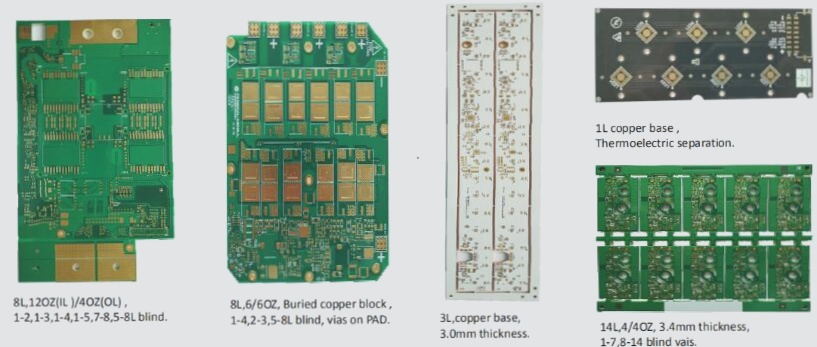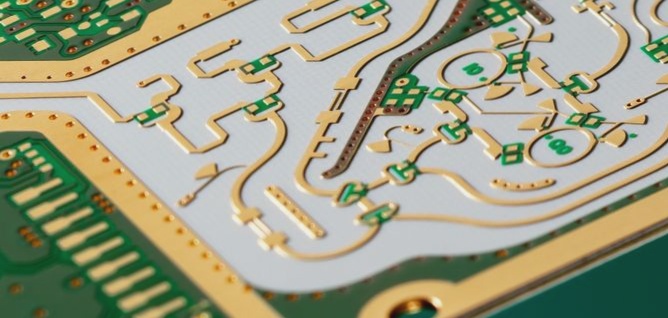**Definition of PCB Lamination:**
It is the process of bonding each layer of a circuit board into a unified whole. The entire process includes kiss pressure, total pressure, and cold pressure. During the kiss pressure stage, the resin penetrates the bonding surface, fills the gaps in the layers, and then moves to full pressure bonding to address all gaps. Cold pressing refers to the rapid cooling of circuit boards to ensure dimensional stability. In circuit board manufacturing, lamination occurs after applying the inner layers to the PCB, which consists of substrates, laminates, solder masks, and screen printing.
**The Steps of the PCB Lamination Process Flow:**
The PCB lamination process involves combining multiple layers of materials to form a single structure. Typically, circuit boards feature thin copper layers sandwiched between thermosetting resin substrates. This process stacks multiple single-layer PCB boards and then presses them into an ordered, multi-layer structure, incorporating electrical connectivity.

1. The first step is to prepare the PCB board. Each single-layer board must undergo chemical drilling and contour processing before being assembled into a multi-layer structure. At this stage, cutting, splicing, and thickness measurement are required.
2. The second step is copper plating. In this step, the prepared PCB board needs to be copper-plated to enhance its conductivity.
3. The third step is arranging the board layer sequence. Before combining single-layer boards into multi-layer boards, they must be stacked in the correct order. CAD software is typically used to design the correct layer sequence.
4. The fourth step is ink printing. This step involves applying targeted ink to print necessary markings and patterns. These markings and patterns are crucial for the subsequent assembly and manufacturing of the board layers.
5. The fifth step is pressing. Once all single-layer boards are assembled and printed, they can be combined into a multi-layer structure through a pressing process. A thermal compressor is usually used for curing.
6. The sixth step is electrical connection. Connecting multiple layers of PCB boards to each other and integrating external components is the final step. Drill holes to connect the components of each layer and link external and internal components to complete the electrical connection of the PCB board.
### The Importance of the PCB Lamination Process Flow:
The PCB lamination process is a critical component of the electronic manufacturing industry. Its importance lies in:
1. **Improving Production Efficiency**
The PCB lamination process enables the simultaneous manufacturing of multiple PCB boards, thereby enhancing production efficiency. This capability helps meet market demand and improves customer satisfaction.
2. **Enhancing Quality**
The PCB lamination process ensures the integrity and reliability of the PCB board. It maintains consistency across PCB boards in the ecosystem and raises their quality standards.
3. **Advancing PCB Design**
The PCB lamination process offers designers new possibilities for design. It allows control over the thickness, number of layers, and arrangement of the board, improving device integration without compromising signal transmission.
The PCB lamination process is crucial in PCB board manufacturing, involving assembly, printing, and hot pressing. Proper execution of these processes boosts production efficiency, meets market demand, and enhances the quality and design of PCB boards.
It is the process of bonding each layer of a circuit board into a unified whole. The entire process includes kiss pressure, total pressure, and cold pressure. During the kiss pressure stage, the resin penetrates the bonding surface, fills the gaps in the layers, and then moves to full pressure bonding to address all gaps. Cold pressing refers to the rapid cooling of circuit boards to ensure dimensional stability. In circuit board manufacturing, lamination occurs after applying the inner layers to the PCB, which consists of substrates, laminates, solder masks, and screen printing.
**The Steps of the PCB Lamination Process Flow:**
The PCB lamination process involves combining multiple layers of materials to form a single structure. Typically, circuit boards feature thin copper layers sandwiched between thermosetting resin substrates. This process stacks multiple single-layer PCB boards and then presses them into an ordered, multi-layer structure, incorporating electrical connectivity.

1. The first step is to prepare the PCB board. Each single-layer board must undergo chemical drilling and contour processing before being assembled into a multi-layer structure. At this stage, cutting, splicing, and thickness measurement are required.
2. The second step is copper plating. In this step, the prepared PCB board needs to be copper-plated to enhance its conductivity.
3. The third step is arranging the board layer sequence. Before combining single-layer boards into multi-layer boards, they must be stacked in the correct order. CAD software is typically used to design the correct layer sequence.
4. The fourth step is ink printing. This step involves applying targeted ink to print necessary markings and patterns. These markings and patterns are crucial for the subsequent assembly and manufacturing of the board layers.
5. The fifth step is pressing. Once all single-layer boards are assembled and printed, they can be combined into a multi-layer structure through a pressing process. A thermal compressor is usually used for curing.
6. The sixth step is electrical connection. Connecting multiple layers of PCB boards to each other and integrating external components is the final step. Drill holes to connect the components of each layer and link external and internal components to complete the electrical connection of the PCB board.
### The Importance of the PCB Lamination Process Flow:
The PCB lamination process is a critical component of the electronic manufacturing industry. Its importance lies in:
1. **Improving Production Efficiency**
The PCB lamination process enables the simultaneous manufacturing of multiple PCB boards, thereby enhancing production efficiency. This capability helps meet market demand and improves customer satisfaction.
2. **Enhancing Quality**
The PCB lamination process ensures the integrity and reliability of the PCB board. It maintains consistency across PCB boards in the ecosystem and raises their quality standards.
3. **Advancing PCB Design**
The PCB lamination process offers designers new possibilities for design. It allows control over the thickness, number of layers, and arrangement of the board, improving device integration without compromising signal transmission.
The PCB lamination process is crucial in PCB board manufacturing, involving assembly, printing, and hot pressing. Proper execution of these processes boosts production efficiency, meets market demand, and enhances the quality and design of PCB boards.


